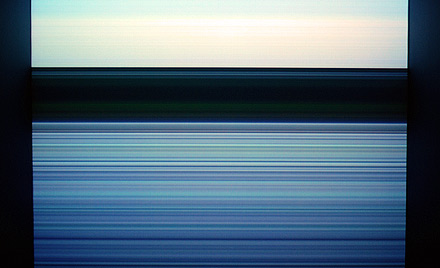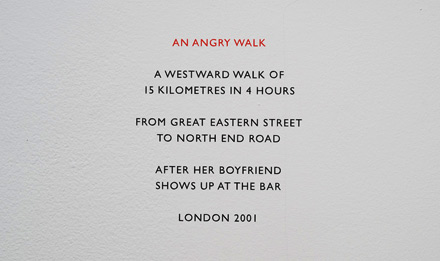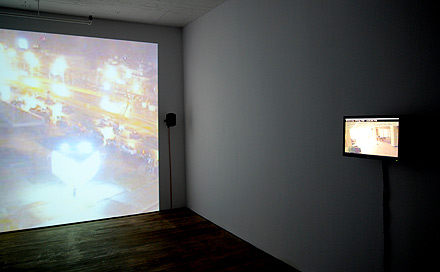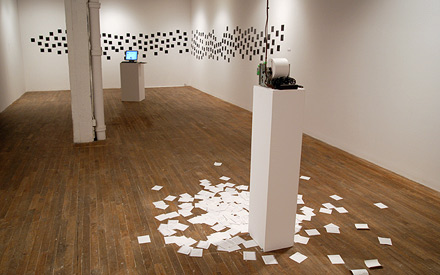The centre d’artistes OBORO in Montréal is currently showing a brilliant little exhibition on the subject of Travelling Without Moving.
Curated by Susanne Jaschko, the former head of Transmediale Berlin, the show approaches the subject from many different angles, with each work commenting on a certain aspect of our changed perception of the world, due to technologies of mediation which “increased the speed of travel and the range of distances that could be reached in real time” but aguably also “disconnect the traveller from his surroundings” and for many also result in a certain inability to penetrate through the surface of a foreign city or culture. Maybe “travelling without moving, and perhaps without being moved”.
As mentioned, all six artworks approach this notion differently but share a very minimalist approach to the subject, no massive sensor or social networks set up, rather pointing out little aspects of a related notion in digital culture.
 Flatland
Flatland
Brazilian artists Angela Detanico and Rafael Lain for instance create their work Flatland from a single line of pixels which they took from a video they show while travelling down the Mekong river. All you see is lines of colors, yet you hear the original sound of the recording which together creates a surreally abstract rendering of what one would expect to be a scenic landscape.
In contrast Radioqualia a.k.a. Adam Hyde and Honor Hager from New Zealand point their attention into deep space. Their audio-installation Radio Astronomy “considers radio telescopes to be radio receivers, which are listening to radio signals being transmitted from planets and stars. Thinking of radio in this way radically enlarges the concept…many of the sounds emitted by these objects are fascinating from both an aesthetic and conceptual perspective, prompting comparisons with avant-garde music and electronic sound art. Yet very few people have heard these sounds, considering space to be silent, rather than the rich acoustic environment it turns out to be.”
The installation will allow you to listen to the live (at least as live as light-speed can be) emissions from Jupiter, Quasars or other objects in space – whatever the connected radio-telescopes are pointing at. Radio Astronomy takes into account that our “understanding of space has been derived by listening to space through radio telescopes”, radiation that has essentially travelled to us for sometimes millions of years.
 Walking Long And Hard
Walking Long And Hard
Walking Long And Hard by Heman Chong from Singapore is kind of scattered across the gallery space and provides for a haiku-esque experience with his short, yet powerful texts. In the spirit of Richard Long‘s walking performances, they recall fragments of memories from emotionally charged walks in different cities around the world which resonate with you on different levels, depending on whether you know the city or have had a similar experience, maybe in a different spot on the planet.
Jérome Joy’s nocinema.org does not try to tap into one’s memory but travels to various webcams around the world and blows their visual feeds up two screens and a big projection to create an “automatic net-based documentary/fiction”. Being a composer himself, he collaborated with numerous artists like Magali Babin, DinahBird, Christophe Charles, Yannick Dauby, Luc Kerléo, Alain Michon, Jocelyn Robert and Chantal Dumas to create a somewhat suggestive soundtrack for the piece.
Sometimes it works well, sometimes the sound is a bit off, but this also, together with the often bizarrely underexposed or overcompressed images create landscapes in their own right, often with a very Non-place-atmosphere to them, deserted parking lots and the likes. The installation allows for visually travelling both around the world (never knowing where the videostream comes from), yet also within one’s narrative imagination due to the cues it gives our experience with filmic works of fiction.
 nocinema.org
nocinema.org
Our (that’s Sascha Pohflepp and Jakob Schillinger) work Fixr wants to pose the question whether an event has happened less when there is no photographic record of it, ideally shared on one’s Flickr photostream. To research into this matter, we set up www.fixr.org in 2005 which claims to “close the gaps in the digital record of your life” that appeared when you forgot your camera and saw that one perfect sunset – ” just submit a detailled description of the moment you missed to us and we’ll do our very best to provide you with an image to fit your needs”.
Over time a collection of moments accumulated which range from childhood memories from the 1970s to often incredibly detailled situations and countless impressions of friends and lovers. Although there are many situations of travel involved, those stories allow the reader to rather travel in someone else’s memory, turning into images while you read them. In the exhibition, a selection of the moments is on the wall and there’s also a computer to share a moment. The same moments can also be found on Flickr.
 The Universal Digest Machine and Fixr in the background
The Universal Digest Machine and Fixr in the background
Finally, the The Universal Digest Machine by Marius Watz is also a web-related work that does the travelling (read: surfing) for you. Like Google’s little helpers, it crawls the web and constantly analyzes the content of the pages it visits, compulsively sorting the content by frequency of words and other technicalities. However, it doesn’t feed it into a database for future use but prints it on a piece of paper and increasingly litters the floor of the gallery with its findings, creating an absurd paper travel diary of its journey through an abstract landscape.
Exhibition runs through December 8th, see more images on Flickr.
